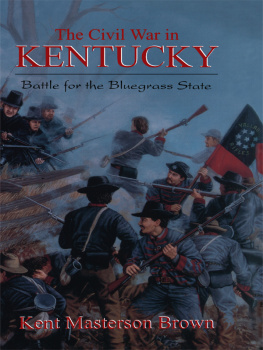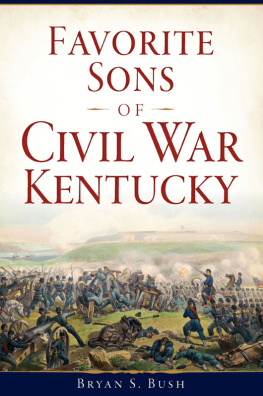Border Wars
BORDER
WARS
The Civil War in Tennessee and Kentucky
Edited by Kent T. Dollar, Larry H. Whiteaker,
and W. Calvin Dickinson
THE KENT STATE UNIVERSITY PRESS
Kent, Ohio
2015 by The Kent State University Press, Kent, Ohio 44242
All rights reserved
Library of Congress Catalog Card Number 2014049701
ISBN 978-1-60635-241-0
Manufactured in the United States of America
Library of Congress Cataloging-in-Publication Data
Border wars : the Civil War in Tennessee and Kentucky / edited by Kent T. Dollar,
Larry H. Whiteaker, and W. Calvin Dickinson.
pages cm
Includes bibliographical references and index.
ISBN 978-1-60635-241-0 (hardcover : alk. paper)
1. TennesseeHistoryCivil War, 18611865Campaigns. 2. KentuckyHistory
Civil War, 18611865Campaigns. 3. TennesseeHistoryCivil War, 18611865
Biography. 4. KentuckyHistoryCivil War, 18611865Biography. I. Dollar, Kent T.
II. Whiteaker, Larry H. (Larry Howard), 1946 III. Dickinson, W. Calvin.
E470.4.B67 2015
976.8'04dc23
2014049701
19 18 17 16 15 5 4 3 2 1
Contents
Preface and
Acknowledgments
The idea for this book has been on our minds for some time. Indeed, as we were working on Sister States, Enemy States: The Civil War in Kentucky and Tennessee (2009), we recognized that because it focused exclusively on the political, economic, and social aspects of the conflict, a second, follow-up volume would be necessary, for there was much more to say about the war in these two states, particularly regarding military matters. The book is divided into two partsPart I: Battles, Skirmishes, and Soldiers and Part II: Leadersand promises to help fill a gap in the existing scholarship on Kentucky and Tennessee during the Civil War period. The state of Tennessee is second only to Virginia in the number of battles fought on its soil, and Kentucky, because of its geographical location, became a state vital to both the Union and the Confederacy. But these two states have not received the attention by scholars that they deserve, and few works have dealt exclusively with these two important states. However, attention is now shifting to the Civil War in Tennessee and Kentucky with Benjamin Franklin Coolings important studies, Fort Donelsons Legacy: War and Society in Kentucky and Tennessee, 18621863 (1997), Forts Henry and Donelson: The Key to the Confederate Heartland (2003), and more recently To the Battles of Franklin and Nashville and Beyond: Stabilization and Reconstruction in Tennessee and Kentucky, 18641866 (2012), as well as our own Sister States, Enemy States.
We wanted to avoid a retelling of the major battles that occurred in Kentucky and Tennessee that both scholars and enthusiasts know so well and focus instead on other aspects of the war there. However, one never knows what direction a project such as this will go when it is undertaken, but we are delighted that the chapters in this volume include a wealth of material not previously published and offer new perspectives on the conflict in these two states.
Anyone who has published a book knows that it is a collaborative effort that involves many different people at many different levels. First of all, we would like to thank the scholars who contributed chapters. Although quite busy with their own projects, they were enthusiastic about this endeavor from the beginning and, believe it or not, met the deadlines we set. It has been a pleasure to work with each and every one of them.
We would also like to express our gratitude to The Kent State University Press, which embraced the project from day one. In particular, we would like to thank Joyce Harrison, Will Underwood, Mary Young, Christine Brooks, Darryl Crosby, Carol Heller, Valerie Ahwee, and Susan Cash, as well as other members of the staff. Without their support, expertise, and guidance, there would be no book. We are grateful to Frank Cooling, James Ramage, and Ken Noe, who read the manuscript and offered their feedback on it and the project as a whole. Their constructive comments made the book much better than it would have been otherwise. We are also indebted to our cartographer, Mary Eggart. The maps she designed for this volume are superb, and she was an absolute pleasure to work with.
We would also like to thank our colleagues in the History Department at Tennessee Tech University. We very much appreciate their interest in and support of our work on this volume.
Civil Warera Tennessee and Kentucky.
When the Civil War erupted in the spring of 1861, the sister states of Kentucky and Tennessee assumed enormous importance to both the Union and the Confederacy. The side that controlled the two states would control the Ohio and Tennessee valleys and, for all practical purposes, the upper reaches of the Mississippi Valley. Because the nations canal network and burgeoning railroad system already linked the Northern states to one another and to ports on the Atlantic, the internal rivers were less important than they once had been, but they were still of vital importance to the national and regional economies, especially to the Confederacy, where canals and railroads were relatively sparse. Furthermore, as Jefferson Davis and his new government well knew, Kentucky and Tennessee were highly diversified agricultural states that at the wars start already supplied vast quantities of pork, beef, wheat, corn, and other comestibles that the Lower South, with its cotton-oriented economy, desperately needed. Also, the South had long neglected industry, and many of its factories were in Tennessee and Kentucky. If either state remained in the Union, the Confederacy would suffer a major blow. The new nation needed Tennessee and Kentucky, and it needed its northern border to be the Ohio River.
Abraham Lincolns oft-cited statement that he hoped God was on his side but that he had to have Kentucky aptly sums up the importance to the Union of the trans-Appalachian region. The prospect of a Confederate Kentuckyand perhaps even a Confederate Missourino doubt gave Lincoln and any other Northern strategist grave concern. An enemy state on the south side of the Ohio River would have threatened Pennsylvania, Ohio, Indiana, and Illinois, and, more than likely, would have made it impossible to keep Missouri in the Union. Southern Illinois, with its large population of Confederate sympathizers, would have perhaps become fertile ground for further secession agitation. To Northern war planners, Kentucky had to be kept in the Union, and Tennessee had to beif not kept in the Unionoccupied and neutralized as soon as possible.
So the lines were drawn by the summer of 1861, and the games began in Tennessee and Kentucky to determine where the border of the Confederate States of America would be. The Fort Sumter battle in April 1861 had shattered any hope for a peaceful separation of the South from the North, so where the boundary would beand who would determine itbecame a major focus of the ensuing war. Kentucky and Tennessee. Tennessee and Kentucky. Sister states. Would they now be enemy states?1
From the 1770s, when settlers from Virginia and North Carolina began to move into the lush valleys of East Tennessee and central Kentucky, these two states would be linkedwhether the residents wished this or notin the national consciousness. Even with many similaritiesterrain, climate, settlers background, religion, to name a fewthere would always be major differences. By the 1820s, for example, a huge political rift would develop, pitting the followers of Kentuckys Henry Clay against Tennessees followers of Andrew Jackson. The ultimate difference would come in 1861.








